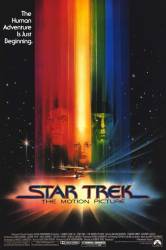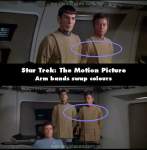Continuity mistake: In the original series Spock mentioned that Vulcan has no moons. In the movie, when Spock is on Vulcan, he looks up and shields his eyes against the glare of the sun. When the scene changes, it is night and there are moons. (Corrected in the Director's Edition).
Suggested correction: Though the planet had no moons, it did form a binary pair with T'Khut and was considered its sister planet. From Memory Alpha.
Trivia: A constant question during the run of all the Trek series is why Klingons look so much different from Star Trek: The Motion Picture on than they did in the original series. The real reason is the movies and later TV series had a better makeup budget. However, the Star Trek: Enterprise episodes "Affliction" and "Divergence" provide a canon answer. Klingons acquired genetically engineered human embryos left over from Earth's Eugenic Wars and used them to augment their soldiers. It worked but created a virus that threatened to annihilate the Klingon race. Dr. Phlox and a Klingon doctor found a cure, but it resulted in all Klingons becoming far more human in appearance. Sometime between these episodes and the first Trek movie a cure was found, returning the Klingons to their present day "ridged-head" appearance.
Suggested correction: Star Trek: Discovery establishes that not all Klingons were affected by the Augment virus. Therefore, the Klingons in Star Trek: The Motion Picture were not cured at all but in fact never contracted the virus. In time, the survivors of the Augment virus did regain their ridges, as shown with Kor, Kang, and Koloth in Star Trek: Deep Space Nine. Before anyone else brings it up, the hairless look of the Klingons in Star Trek Discovery season 1 was a ritual they underwent when going to war, a ritual that fell out of favor in the intervening years. Star Trek Discovery season 2 shows Klingons with hair.






